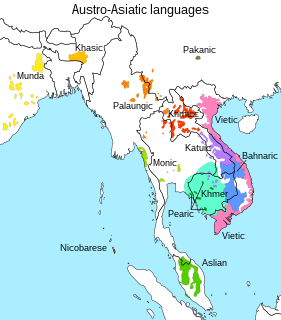Related Research Articles

The Austroasiatic languages, also known as Mon–Khmer, are a large language family of Mainland Southeast Asia, also scattered throughout parts of India, Bangladesh, Nepal, and southern China. There are around 117 million speakers of Austroasiatic languages. Of these languages, only Vietnamese, Khmer and Mon have a long-established recorded history and only Vietnamese and Khmer have official status as modern national languages. The Mon language is a recognized indigenous language in Myanmar and Thailand. In Myanmar, the Wa language is the de facto official language of Wa State. Santali is one of the 22 scheduled languages of India. The rest of the languages are spoken by minority groups and have no official status.

The fifteen Katuic languages form a branch of the Austroasiatic languages spoken by about 1.3 million people in Southeast Asia. People who speak Katuic languages are called the Katuic peoples. Paul Sidwell is the leading specialist on the Katuic languages. He notes that Austroasiatic/Mon–Khmer languages are lexically more similar to Katuic and Bahnaric the closer they are geographically. He says this geographic similarity is independent of which branch of the family each language belongs to. He also says Katuic and Bahnaric do not have any shared innovations, so they do not form a single branch of the Austroasiatic family, but form separate branches.

The nearly thirty Palaungic or Palaung–Wa languages form a branch of the Austroasiatic languages.

The Khmuic languages are a branch of the Austroasiatic languages spoken mostly in northern Laos, as well as in neighboring northern Vietnam and southern Yunnan, China. Khmu is the only language in the group that has many speakers.
The Pacoh language is a member of the Katuic language group, a part of the Eastern Mon–Khmer linguistic branch. Most Pacoh speakers live in central Laos and central Vietnam. Pacoh is undergoing substantial change, influenced by the Vietnamese.
Maleng, also known as Pakatan and Bo, is a Vietic language of Laos and Vietnam.
Bruu is a Mon–Khmer dialect continuum spoken by the Bru people of mainland Southeast Asia.
Oi is an Austroasiatic dialect cluster of Attapeu Province, southern Laos. The dominant variety is Oy proper, with 11,000 speakers who are 80% monolinguals. The Jeng (Cheng) speak the same language but are ethnically distinct. Speakers follow traditional religions.
The Khasi–Palaungic languages are a primary branch of the Austroasiatic language family of Southeast Asia in the classification of Sidwell. This is a departure from Diffloth (2005) classification of Khasi-Khmuic with Khmuic and Mangic (Pakanic) now being separate branches within Austroasiatic family.
Katu, or Low Katu, is a Katuic language of eastern Laos and central Vietnam.
Ta'Oi is a Katuic dialect chain of Salavan and Sekong provinces in Laos, and in Thừa Thiên-Huế province in Vietnam.
Laven is a Mon–Khmer dialect cluster of southern Laos. Laven is the exonym given by the Laotian government, while the autonym of many of those speakers is Jru' [ɟruʔ]. Varieties are:
Brao is a Mon–Khmer language of Cambodia and Laos.
Su' is a Mon–Khmer language of the Bahnaric branch spoken in Attapeu Province, Laos. The 1995 Attapeu census recorded a population of only 124 speakers in Sanamsay District. Su' autonyms are identical with that of the Jru', but they consider themselves to be a separate ethnic group. There could also possibly be speakers in Stung Treng Province, Cambodia.
Riang is a Palaungic language of Burma and China. Speakers are culturally assimilated with the Karen, but are Palaung by ancestry and their language is unrelated. Riang Lang and Riang Lai (Yinchia) are sometimes considered distinct languages.
The Waic languages are spoken in Shan State, Burma, in Northern Thailand, and in Yunnan province, China.
Kháng, also known as Mang U’, is an Austroasiatic language of Vietnam. It is closely related to the Bumang language of southern Yunnan, China.
Nyaheun is a Mon–Khmer language of the Bahnaric branch spoken in southern Laos. Chazée (1999:95) estimates the population at 4,200, while the 1995 Laotian census places the Nyaheun population at 5,152. According to Ethnologue, the language is "vigorous," which means it is spoken by people of all ages in its home community. The same source says the 2015 census puts the population at 9,000 https://www.ethnologue.com/language/nev
Phuong, or High Katu, is a Katuic language (Mon-Khmer) of Vietnam.
The Bit–Khang languages consist of:
References
- ↑ Kiorr at Ethnologue (18th ed., 2015)
Con (spurious per Glottolog) at Ethnologue (18th ed., 2015) - ↑ Hammarström, Harald; Forkel, Robert; Haspelmath, Martin, eds. (2017). "Kiorr". Glottolog 3.0 . Jena, Germany: Max Planck Institute for the Science of Human History.
- ↑ Sidwell, Paul. (2010). Three Austroasiatic branches and the ASJP (Fig. 23)
- ↑ SEALang SALA: Southeast Asian Linguistics Archives
- ↑ Proschan, Frank. (1996). A Survey of Khmuic and Palaungic Languages in Laos and Vietnam. In: Pan-Asiatic Linguistics Proceedings of the Fourth International Symposium on Languages and Linguistics. Institute of Language and Culture for Rural Development. Mahidol University at Salaya Thailand.
| This Austroasiatic language-related article is a stub. You can help Wikipedia by expanding it. |